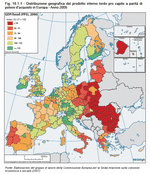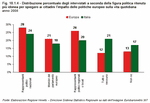The concept of a network has become essential in institutional terms. Administrations and institutions in all fields, including the environment, healthcare, education, transport and economic development, need to work closely with other subjects, both public and private, so that that their services can be carried out to maximum effect.
Over the years, steps have been taken in this direction with the increasingly consolidated concept of
multilevel governance, a new form of government that forms the bases of a modern
modus operandi. "Governance" is an evolution of "government" and tends to describe the formulation and management of public policies in which the State is no longer the only actor involved, and the top-down hierarchy of control loses its centrality. The concept of
governance is the result of the poor performances in countries where the State operated centrally and no power was given to other institutions or to private economic subjects.
With
governance, a wide range of both public and private actors become involved in the political scene. The central role of the State in policy management and law production is replaced by a "system of tiers of government"; the traditional national level now stands alongside a supranational level and sub-national levels. The most interesting and innovative feature is that interaction between the various tiers and network nodes is direct and one-to-one: "in systems of multilevel governance, the national level has lost its prerogative as a nodal filter, i.e. as a
gatekeeper between what is below it (regional and local authorities) and what is outside or above it (government and territorial authorities in other countries and at supranational level)"
(Note 1).
 Time in institutional networks
Time in institutional networks
Institutional networks can be stable or dynamic in accordance with circumstances and economic events. It should be noted that it is especially the factor of time that distinguishes multilevel governance from the government of projects, which comes into force when an institutional network is created to achieve specific objectives. In this case, the coalition between the subjects concerned is temporary, being dissolved as soon as the project that brought it to life is completed. Regulations envisage that public institutions at different levels can enter into agreements and conventions with other institutions, as well as with non-institutional and private bodies (e.g. universities, chambers of commerce, not-for-profit organisations, etc.), in order to achieve a certain end. One example is the institutional networks that Regione Veneto is involved in, as per Regional Law LR no. 55/1999, for the promotion of human rights, peace and development, which we will look at below; these networks have given rise to 750 international projects all over the world since the Regional Law was introduced.
The institutional network at the basis of multilevel governance, however, is not temporary and ad hoc; therefore it is not geared towards a specific short-term result: it is stable, long-lasting and is brought into being to achieve objectives that are to be pursued continually and permanently in the long-term. As with the government of projects, it uses institutional conventions and agreements between public and non-public authorities. In this case, it deals with programme agreements that are based not on a single project, but on a series of initiatives within the environment of a programme, or a line, of intervention to deal with problems that are both extremely complex and important (e.g. sustainability, economic development, environmental protection, the fight against poverty, etc.).
Furthermore, these forms of cooperation are not reduced to the definition of "interventions". The action of the subjects involved also regards the management, implementation, monitoring and continual, life-long evaluation of a project's results in order to make it efficient and effective, adjusting it where necessary. Furthermore, it requires needs analysis, which is conducted above all by listening to citizens so that public action can be geared towards areas that need intervention.
Clearly, all of these activities are fostered by working in a network, which enables both the involvement of the levels of government in closest contact with the population and the participation of different social groups and non-institutional subjects, who bring a more decentralised vision that comes directly from the area involved.
Multilevel governance is the policy model currently used within the European Union and it is based on the EU's White Paper (2009). There is a famous quote from The Berlin Declaration by Heads of State and government, which commemorated fifty years of the Treaty of Rome on 25 March 2007: "There are many goals which we cannot achieve on our own, but only in concert. Tasks are shared between the European Union, the Member States and their regions and local authorities". This statement means that Europe can only be a strong continent if the management of its powers are equally shared between its various parts; only close cooperation between different tiers of governance in the formulation of policies and legislation will render public action effective. This system needs to be shared vertically, i.e. interaction between regional and local bodies, national government and the EU, and horizontally, i.e. the promotion of social dialogue and the active participation of citizens in European political issues.
 Multilevel governance through convergence
Multilevel governance through convergence
Europe's
multilevel governance aims to ensure Member States develop harmoniously by gearing policies towards the bridging of social and economic disparities between various European regions, which have at times been widened by the spread of globalisation. Although between 2000 and 2006, there was a convergence among European regions in terms of Gross Domestic Product (GDP) per capita (the variation coefficient fell by 8%), the geographical distribution of this indicator continues to point to major differences between regions and between the East and the West of the EU in particular, with the exception of Portugal, Spain and southern Italy (other exceptions include the East European capitals Prague, Ljubljana, Bratislava and Budapest)
(Figure 18.1.1).
 Bringing citizens closer to institutions
Bringing citizens closer to institutions
In order to span these disparities, it is necessary to involve local and regional institutions in the planning and implementation of EU strategies. Local authorities must not simply be "intermediaries"; they need to act as "partners" so that EU objectives can be adapted to a wide range of situations. A decentralised liaison policy that brings citizens closer to institutions and involves them in the decision-making process through debates, consultations and assessments, etc. enables diversified measures to be adopted so that the most can be made of the role and the potential of individual regions and cities.
The results of a recent Eurobarometer report on the importance of regional and local institutions in Europe confirms the need to adopt
multilevel governance. Citizens feel there is a need for this form of shared government in order to strengthen public action and to make it more effective. The report reveals that Europeans believe multilevel governance to be a natural step as globalisation grows increasingly stronger. To the question who is most suited to defend interests at supranational level, the answers of the 27,000 European citizens interviewed were equally distributed between Members of the European Parliament, national politicians, and regional and local representatives.
Two results, in particular, suggest that a synergy is needed between higher and lower level institutions, i.e. those closer to citizens. First and foremost, respondents recognised that local and regional bodies play a major role in their lives, especially in Italy where the importance placed on local institutions is higher than that placed on national ones
(Figure 18.1.2).
Similarly, the majority of respondents (almost 60%) retained that regional and local institutions are not suitably taken into account by European decision-makers. Although there is still a certain unawareness of the role that grassroots local institutions play within the European Union (only 24% of European stated that they had heard of The Committee of the Regions, more detail below), the fact that the majority ask for greater involvement of lower-level institutions in the European decision-making process suggests that a form of joint government is needed, on account of the key role that these institutions play in local quality of life
(Figure 18.1.3).
In confirmation of this, 26% of respondents said that local and regional politicians are best placed to explain how EU policies impacted their daily lives
(Figure 18.1.4).









